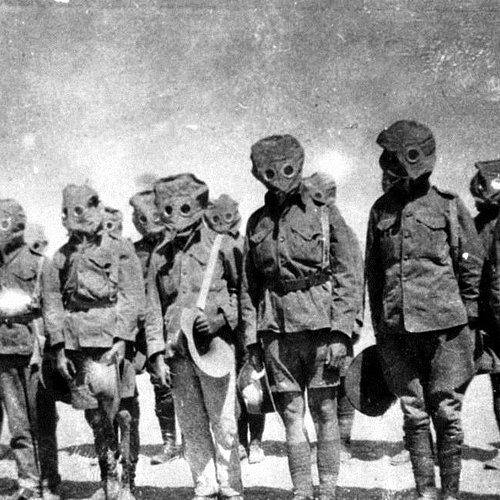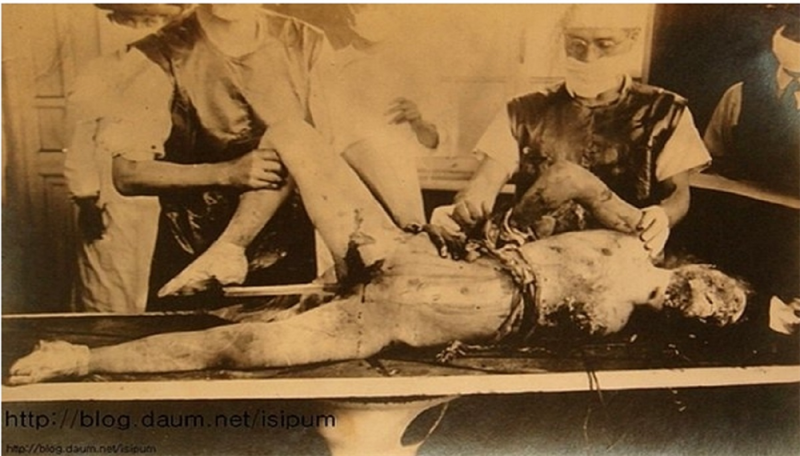
The Geneva Protocol of 1925
Outlawed the use of biological weapons, but you could still own them and you could still do research on them. Many nations still reserved the right to retaliate in kind. The U.S., incidentally, didn’t sign the Protocol until 1975.
Learn more about the history of microbes as weapons
Ironically, it was the Geneva Protocol that started our modern biological arms race. It gave a Japanese microbiologist named Shirō Ishii the idea that biological weapons might actually be both feasible and very powerful. Shirō Ishii was a brilliant, if rather disturbed student, a graduate of Kyoto Imperial University.
He later became the proverbial mad scientist, eager to try any experiment no matter how gruesome, with total indifference to the agonies of his victims.
The Gruesome Experiments of Shirō Ishii

Most of us are familiar with the atrocities committed by the infamous Nazi butcher Josef Mengele, but very few people are aware that Shirō Ishii not only equaled Mengele in cruelty, but greatly exceeded him in the scope and in the savagery of his experiments.
Ishii became the mastermind behind the Japanese biological weapons program. In 1932, he was placed in command of the Army Epidemic Prevention Research Laboratory. I’m going to spare you the grisly details of his legacy of human tragedy and despair—it literally made me sick just to read about—but the final death toll is staggering.
As many as 12,000 victims died from his bizarre experiments and vivisection. A mass grave of his victims, found in 1945 at Hailar, held the remains of 10,000 Chinese and Mongolian men, women, and children.
This is a transcript from the video series Mysteries of the Microscopic World. Watch it now, on The Great Courses Plus.
He started his experiments at Zhongma Fortress in 1932, until bad publicity forced him to relocate. In 1936, he opened the infamous Unit 731 in Manchukuo, China. Unit 731 was a sprawling complex of 150 buildings scattered over 6 square kilometers, and ironically disguised as the Anti-Epidemic Water Supply and Purification Bureau.
His experiments duplicated most of the Nazi atrocities, but he went them one better when it came to germ warfare. His tool kit included cholera, typhus, dysentery, salmonella, typhoid fever, botulin, gas gangrene, smallpox, tuberculosis, and anthrax. His subjects were originally Japanese political prisoners or common criminals.

Later on, he took advantage of the war to experiment on Chinese POWs and civilians, and even American POWs.
Three members of Unit 731 later confessed to using typhoid to contaminate the Horustein River, hoping to infect nearby Soviet troops. Plague infected animals, released during the Russian advance in 1945, may have caused the deaths of over 30,000 Chinese civilians.
He designed one bomb made out of porcelain, stuffed with cotton wadding, wheat, rice, and plague-infected fleas. From October of 1940 to November of the following year, he bombarded several Chinese cities with his little porcelain bombs, including Chu Hsien, Ningbo, and Changteh.
Although 150 people died from these attacks, fortunately, there were no major outbreaks of plague. His repeated use of biological weapons finally backfired in 1942—he learned the same lesson that Hercules did—when Japanese troops retook Chekiang Province from the Chinese.
Learn more about one of the most infamous microbes of all time, Yersinia pestis
Under Ishii’s instruction, they had previously salted several areas with cholera and other microbes in order to deter the Chinese, but 10,000 Japanese soldiers fell ill (mostly from cholera), and 1700 of them died.
The final death toll from Ishii’s microbial warfare is estimated at over 400,000 people. He had even drawn up plans to attack the west coast of the United States using balloon bombs loaded with anthrax. But Ishii and the other doctors who conducted these grisly experiments never paid for their crimes.
In 1945, Gen. MacArthur secretly gave them limited immunity in return for the results of their research, which he didn’t want to fall into Russian hands.
Thirty people from Unit 731 were finally hauled before the Allied war crimes tribunal in 1948, and several of them were actually sentenced to death or lengthy imprisonment. But MacArthur commuted or shortened all of their sentences in 1950, and by the late 1950s they were all free.

Several doctors from Unit 731 went on to prominent careers in Japanese medicine or the pharmaceutical industry. Shirō Ishii himself died at home of cancer at the age of 67. The Japanese refused to even admit the existence of this program until 1997, when the Japanese Supreme Court finally ruled in a textbook suit that its existence was accepted as fact in academic circles.
To this day, they have refused any compensation for the survivors or their families. Unit 731 made the news again in 2010, when the Japanese government announced it was going to excavate the grounds of a former medical school associated with Unit 731. A retired nurse broke 60 years of silence to confess that after the Japanese surrender, she and others were forced to bury many bodies before American troops arrived on the scene.
Weaponizing Anthrax
The Japanese worked hardest at producing an anthrax bomb. For many reasons, anthrax has been a perennial favorite in every nation’s biological arsenal. Anthrax is caused by the bacterium Bacillus anthracis. It isn’t just a disease of sheep, it actually occurs in a wide range of mammals, including, surprisingly, lions and elephants.
It’s an ancient disease; it’s mentioned in the Iliad and it was familiar to Hippocrates. The bacterium forms a spore that is surprisingly durable. Anthrax is acutely infectious to sheep, cattle, and humans. It can be inhaled, enter through the skin, or enter through the gut by eating infected meat. But most normal cases of anthrax involve those who work with raw wool—very raw wool (the kind that goes baa).
 Anthrax is caused by the bacterium Bacillus anthracis (Image: Kateryna Kon/Shutterstock)
Anthrax is caused by the bacterium Bacillus anthracis (Image: Kateryna Kon/Shutterstock)
If the anthrax bacterium is inhaled, the victim begins to cough in a few hours. The symptoms progress to shortness of breath, high fever, convulsions, bleeding from bodily orifices, and a rapid and painful death within 12–24 hours of the first symptoms.
Anthrax spores can remain viable for up to 40–80 years in the soil. It can persist in the dirt for decades, patiently awaiting its next victim. This evolutionary strategy of durability allows anthrax to be highly virulent.
The U.S. Continues to Research
The discovery of Ishii’s work late in the war drew attention to the threat of germ warfare. We were convinced that the Nazis were also developing biological weapons and we were fearful that they would use their V-1 and V-2 rockets to deliver them, so we began to organize our own research program.
The U.S. program officially began in 1942 under the auspices of the Chemical Warfare Service (CWS), later called the Army Chemical Corps, but several sources allege that clandestine biowarfare research was already well underway in 1941.
The U.S. biological warfare program began at Fort Detrick, the Army Medical Research Institute of Infectious Diseases, where it is still located today. Britain and Canada later joined the program.
In 1942, the British military used Gruinard Island, off the coast of Scotland, to test anthrax. This tiny island—it’s only about a mile wide and 1.5 miles long—ended up thoroughly contaminated with anthrax. It even spread to the mainland, probably in the floating corpse of a dead sheep. It killed several pets and several farm animals, but fortunately no people. It took 47 years to clean up the mess.





















By Bruce E. Fleury, Ph.D., Tulane University
The 21st Century
https://www.thegreatcoursesdaily.com/biological-warfare-the-geneva-protocol/
